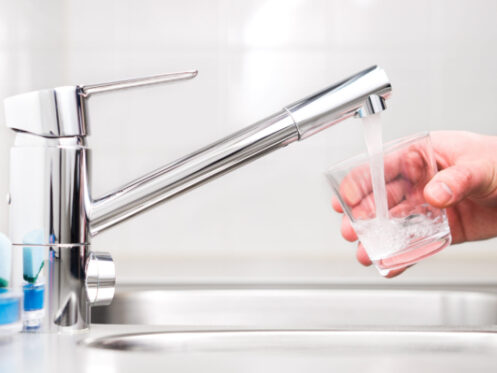Your home’s faucets are among the most indispensable fixtures, and keeping them leak-free and in excellent working condition is essential. Faulty faucets can become major nuisances: dripping, leaking, and sending your utility bills soaring. Understanding the potential causes of leaky faucets can help you spot trouble earlier. Here’s what you need to know.
1. Loose Parts
Loose parts within a faucet are a primary cause of leaks. Faucets aren’t necessarily complicated devices, but they comprise numerous small parts that can become worn and damaged by various factors. For example, friction and pressure can degrade the washer at the base of the faucet stem, which can lead to drips and leaks. Loose O-rings, nuts, and packing nuts within the faucet assembly are also common underlying causes of leaks. These components work together to maintain a watertight seal within the faucet. If they become worn or loose, water can escape, creating a leak that can range from a minor drip to a major stream. Regular use, mineral deposits, or improper installation can worsen the damage. Addressing loose parts by tightening or replacing them with compatible, high-quality replacements will prevent persistent faucet leaks and ensure efficient water usage.
2. Corroded Valve Seat
A corroded valve seat can also trigger faucet leaks. A valve seat is a flat metal part within the faucet body that connects the faucet and spout. When the seal between the valve seat and the faucet deteriorates due to corrosion, mineral buildup, or sediment accumulation, water will leak around the spout. Exposure to hard water accelerates corrosion, gradually removing the seat’s smooth surface and causing irregularities that compromise the seal. Such corrosion lets water seep out and damage the faucet’s internal components.
Regular cleaning and maintenance to remove mineral deposits and sediment can prevent valve seat corrosion. Properly replacing or resurfacing the valve seat, especially when signs of damage emerge, is crucial to ensure a tight seal and prevent persistent faucet leaks, conserving water and maintaining proper functionality.
3. Broken O-Rings
Broken O-rings are frequently behind leaky faucets. These small rubber rings form a seal between connected parts of the faucet, such as the spout and the body. When they deteriorate or break due to age, wear, or improper installation, they lose their ability to maintain a watertight seal. Consequently, water can seep through the gaps, causing leaks around the base of the faucet or handles.
Exposure to mineral deposits in hard water can accelerate O-ring degradation. Regular use and the constant expansion and contraction of the rings during temperature changes also contribute to their breakdown. Replacing damaged O-rings with compatible, high-quality ones will restore the seal and prevent ongoing leaks for the continued efficient functioning of the faucet and the conservation of water resources.
4. Water Pressure
This is another common cause of faucet leaks. Excessive water pressure, often caused by issues within the plumbing system, can strain the faucet components. When the pressure surpasses the faucet’s designed limits, it puts undue stress on the seals, washers, and other internal parts, and can lead to leaks. High water pressure can also degrade washers, displace O-rings, or even damage the valve seat, all of which can create further avenues for leaks.
Conversely, low water pressure might cause irregular flow, resulting in worn-out seals or washers due to constant adjustments in pressure. Maintaining regulated water pressure through a pressure-reducing valve and periodically checking and adjusting it within recommended levels helps prevent unnecessary strain on faucet components, minimizing the risk of drips and wasted water.
5. Worn-Out Washers
Positioned at the base of the faucet stem, rubber or plastic washers form a tight seal against the valve seat to prevent water from flowing out when the faucet is turned off. The constant friction and compression as they operate causes them to deteriorate. Over time, they lose their ability to create an effective seal. As the washers degrade, water will escape and constantly drip or leak from the faucet.
Commonly found in compression faucets, worn-out washers should be replaced promptly to restore the watertight seal. This is a job that typically requires basic tools and a compatible replacement washer to efficiently address the leak issue. Regular inspection and timely replacement of these washers can keep your faucet drip-free and your water bills affordable while avoiding wasted water.
6. Improperly Installed Washer
An improperly installed washer is a major cause of leaky faucets. A washer that is too loose will be unable to create a proper seal, allowing water to seep through. An excessively tight washer can cause friction, leading to premature wear and leaks. Using a washer that does not match the manufacturer’s specifications for that particular faucet model or quality standards can lead to similar issues.
Proper installation involves placing the washer securely and ensuring it fits snugly, without being too loose or tight, to maintain an effective seal and prevent leaks around the faucet.
7. Lime Accumulation
In hard water, minerals like calcium and magnesium build up over time, forming lime deposits within the faucet assembly. These deposits adhere to various components, including the aerator, valves, and seals. Lime accumulation hampers the proper functioning of the faucet by obstructing the flow of water and compromising seals. The deposits can erode rubber washers, damage O-rings, and hinder the smooth operation of moving parts. As a result, leaks can occur around the spout or handles. Regular cleaning and maintenance using vinegar or commercial descaling solutions help dissolve and remove lime deposits, ensuring the efficient functioning of the faucet and preventing persistent leaks caused by limescale buildup and hard water deposits.
8. Broken Plumbing
This often serves as a fundamental cause of faucet leaks. Issues within the plumbing system, such as damaged pipes, fittings, or connections, can lead to water leakage near or around the faucet. Cracked or deteriorated pipes, often due to age, freezing temperatures, corrosion, or physical damage, can allow water to escape, which manifests as leaks around the faucet. Additionally, loose or poorly connected plumbing fittings, joints, or couplings can create gaps that let water seep out around the faucet.
Furthermore, excessive pressure or irregular water flow caused by plumbing problems can strain the various components of the faucet, leading to leaks. Regularly inspecting the plumbing system, addressing any signs of damage or wear, and promptly repairing or replacing compromised pipes and fittings are essential preventive measures to minimize leaks from broken plumbing and maintain a properly functioning faucet.
Professional Plumbing and HVAC Services in Vacaville
Is your faucet leaking? Do you have a constant, annoying drip? Are your water bills skyrocketing? An experienced plumber can help you track down the source of the problem and get it under control. At Cozy Home Services, we have a team of highly qualified plumbers guaranteed to deliver quality workmanship. Whether it is plumbing, electrical, HVAC, or indoor air quality services, we are available 24/7 to get your system back in working order. Get in touch with us today at Cozy Home Services in Vacaville for more information.



